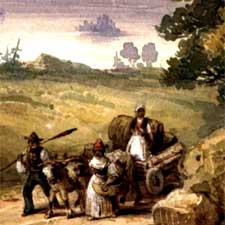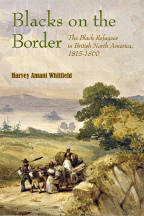| Blacks on the Border |
 SEACOAST BOOKS
SEACOAST BOOKS
Each new black heritage study contributes to our understanding of race in America. This volume focuses on the little-told story of black refugees on the move to Nova Scotia in the years leading up to the Civil War and the African culture they created there.
VISIT OUR Black History web site
A study of the emergence of community
among African Americans in Nova Scotia.
Connections between Seacoast New Hampshire and Nova Scotia are strong. It was the success of fishing in the Maritimes, in Maine and at the Isles of Shoals that drew some of the earliest entrepreneurs, adventurers and settlers here. The oldest stones in many Nova Scotia cemeteries include the bones of New England Loyalists who fled there at the time of the American Revolution. Portsmouth’s own governor, John Wentworth, became governor of Nova Scotia at Halifax.
 Blacks also fled to Nova Scotia. This study of black refugees to British Canada fills in another part of the puzzle that is African American history. Slowly the simplistic view of blacks fleeing to Canada on the legendary "underground railroad" is evolving into a more authentic study of the spread of African culture throughout the northern hemisphere. Studying the scattered migration or "Diaspora" of blacks away from slavery toward freedom is giving us a clearer picture of the scope of American history from early colonization, through the Civil War and Civil Rights to the modern day.
Blacks also fled to Nova Scotia. This study of black refugees to British Canada fills in another part of the puzzle that is African American history. Slowly the simplistic view of blacks fleeing to Canada on the legendary "underground railroad" is evolving into a more authentic study of the spread of African culture throughout the northern hemisphere. Studying the scattered migration or "Diaspora" of blacks away from slavery toward freedom is giving us a clearer picture of the scope of American history from early colonization, through the Civil War and Civil Rights to the modern day.
SEE ALSO: Black Portsmouth
Readers will be surprised to note that the black populations of Rhode Island, Boston and Nova Scotia all hovered around the 2000 mark in this era. This study pulls together research about the Canadian border which research shows included two-way traffic of blacks both coming and going. -- JDR
Detail of cover illustration shows Bedford Basin near Halifax by Robert Petley, circa 1835, National Archives of Canada.
BUY THIS BOOK
Blacks on the Border
The Black Refugees in British North America, 1815–1860
By Harvey Whitfield
University of Vermont Press / UPNE 2006
University Press of New England
200 pp. 2 maps. 6 x 9"
African-American Studies / Diaspora Studies
$24.95 Paper
FROM THE PUBLISHER
Following the American Revolution, free black communities and enslaved African Americans increasingly struggled to reconcile their African heritage with their American home. This struggle resulted in tens of thousands of African Americans seeking new homes in areas as diverse as Haiti and Nova Scotia. Black refugees arrived in Nova Scotia after the War of 1812 with little in common but their desire for freedom. By 1860, they had formed families, communities, and traditions.
Harvey Amani Whitfield’s study reconstructs the lives and history of a sizeable but neglected group of African Americans by placing their history within the framework of free black communities in New England and Nova Scotia during the nineteenth century. It examines which aspects of American and African American culture black expatriates used or discarded in an area that forced them to negotiate the overlapping worlds of Great Britain, the United States, Afro–New England, and the African American Diaspora, while considering how former American slaves understood freedom long before the Civil War.
HARVEY AMANI WHITFIELD is Assistant Professor of History at the University of Vermont.
TABLE OF CONTENTS
Introduction
Nova Scotian and American Background, 1605–1815
Slavery and Freedom in Nova Scotia
Two Distinct Cultures of Slavery
Opportunities and Obstacles in Nova Scotia, 1815–1860
Settlement and Struggle
Working Folks
Community and Identity
Epilogue
